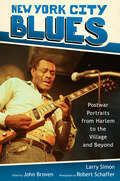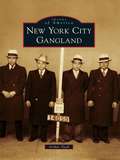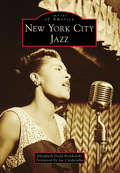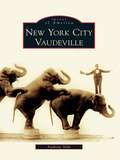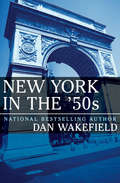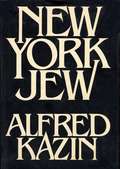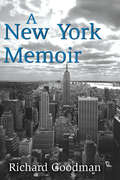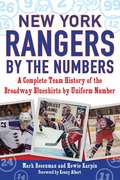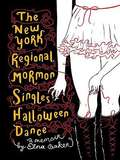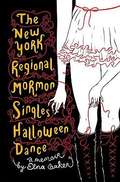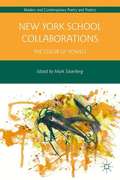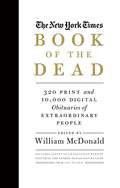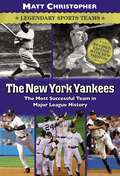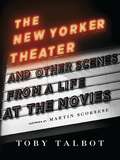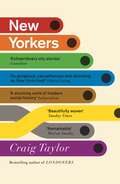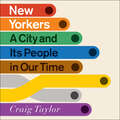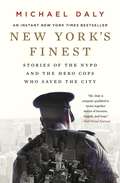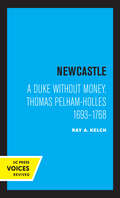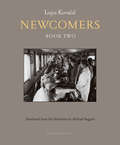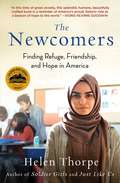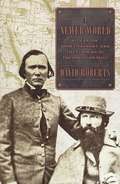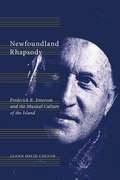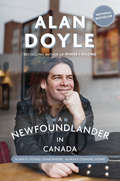- Table View
- List View
New York City Blues: Postwar Portraits from Harlem to the Village and Beyond (American Made Music Series)
by Larry SimonA first-ever book on the subject, New York City Blues: Postwar Portraits from Harlem to the Village and Beyond offers a deep dive into the blues venues and performers in the city from the 1940s through the 1990s. Interviews in this volume bring the reader behind the scenes of the daily and performing lives of working musicians, songwriters, and producers. The interviewers capture their voices — many sadly deceased — and reveal the changes in styles, the connections between performers, and the evolution of New York blues. New York City Blues is an oral history conveyed through the words of the performers themselves and through the photographs of Robert Schaffer, supplemented by the input of Val Wilmer, Paul Harris, and Richard Tapp. The book also features the work of award-winning author and blues scholar John Broven. Along with writing a history of New York blues for the introduction, Broven contributes interviews with Rose Marie McCoy, “Doc” Pomus, Billy Butler, and Billy Bland. Some of the artists interviewed by Larry Simon include Paul Oscher, John Hammond Jr., Rosco Gordon, Larry Dale, Bob Gaddy, “Wild” Jimmy Spruill, and Bobby Robinson. Also featured are over 160 photographs, including those by respected photographers Anton Mikofsky, Wilmer, and Harris, that provide a vivid visual history of the music and the times from Harlem to Greenwich Village and neighboring areas. New York City Blues delivers a strong sense of the major personalities and places such as Harlem’s Apollo Theatre, the history, and an in-depth introduction to the rich variety, sounds, and styles that made up the often-overlooked New York City blues scene.
New York City Gangland (Images of America)
by Arthur NashThroughout the United States, there is no single major metropolitan area more closely connected to organized crime's rapid ascendancy on a national scale than New York City. In 1920, upon the advent of Prohibition, Gotham's shadowy underworld began evolving from strictly regional and often rag-tag street gangs into a sophisticated worldwide syndicate that was--like the chocolate egg crème--incubated within the confines of its five boroughs. New York City Gangland offers an unparalleled collection of rarely circulated images, many appearing courtesy of exclusive law enforcement sources, in addition to the private albums of indigenous racketeering figures such as Charles "Lucky" Luciano, Al "Scarface" Capone, Joe "The Boss" Masseria, "Crazy" Joe Gallo, and John Gotti.
New York City Jazz
by Joe Cinderella Elizabeth Dodd BrinkofskiNew York City Jazz explores many of the haunts and hideaways that have played host to iconic jazz musicians and singers like Charlie Parker, Miles Davis, John Coltrane, Bill Evans, Billie Holiday, Dizzy Gillespie, and Lester Young. Considered the jazz capital of the world, New York City is known for its flashy venues. The stages of the Latin Quarter, Apollo Theater, Minton's Playhouse, Onyx, Stork Club, Downbeat Club, Birdland, Roseland, and Copacabana came to life with the sounds of pianos, drums, horns, and gypsy guitars. This collection of images presents why Fifty-second Street was nicknamed "Swing Street" and how musicians made timeless names for themselves in the Empire City.
New York City Vaudeville
by Anthony SlideNew York City Vaudeville provides a unique pictorial record of America's preeminent entertainment medium in the late 1800s through the early 1930s. New York's Palace Theatreserved as the flagship for vaudeville, on which stage everyvaudevillian aspired to perform. New York City Vaudevillefeatures photographs of some of the greatest names fromthe Palace Theatre, including Jack Benny, George Burnsand Gracie Allen, Anna Held, the Marx Brothers, and Eva Tanguay, as well as legendary African American performers such as Bill Robinson, Ethel Waters, and Bert Williams. Through the photographs and the capsule biographies, the reader is transported back to a time when vaudeville was the people's entertainment, with a new bill of fare each week and an ever-changing number of performers with ever-changing styles of presentation.
New York in the '50s
by Dan WakefieldThe rhythms of jazz and beat poetry punctuate this sweeping, firsthand account of New York City's 1950s literary scene from the Bowery to Spanish Harlem National bestselling author Dan Wakefield first came to New York City in 1952 with the intention of receiving a proper literary education on the ivied campus of Columbia University. An equally enlightening experience, he quickly found, was hiding in the smoky bars and cafés of Greenwich Village frequented by the most talented writers of the fifties, including James Baldwin, Joan Didion, and Allen Ginsberg. Wakefield recounts drinking at the White Horse Tavern, Dylan Thomas's Village haunt, as well as the offices of Esquire and the Nation, capturing rare, intimate moments of spirited camaraderie between some of the most influential artists of their generation. Like Hemingway's recollections of 1920s Paris in A Moveable Feast, New York in the '50s showcases a city in its artistic heyday, replete with Wakefield's remembrances of brushing shoulders with literary icons such as Jack Kerouac and Norman Mailer, and watching Thelonious Monk play jazz at the Five Spot Café. Wakefield's experience as a journalist and chronicler of Americana allows him to capture the subtleties of a decade of unparalleled artistic expression.
NEW YORK JEW
by Alfred KazinAlfred Kazin, one of the central figures of America's intellectual life in the 20th century, takes us into his own life and times. His autobiography encompasses, within a single large, fluent narrative, a personal story openly told; an inside look at New York's innermost intellectual circles; and brilliantly astute observations of the literary accomplishments, atmosphere, and fads of the 1940's, '50's, and '60's in the context of America's shifting political gales. Kazin begins his story in 1940, where we see him first as a young man working for The New Republic, then for Fortune in the time of James Agee. We see him in wartime London; as traveler, after the war, in Italy, Germany, Russia and Israel. We see him as teacher and scholar; as husband and lover; as a writer of profoundly influential critical works; as both observer of and participant in the cultural history of his time. Marvelous scenes of close-up encounters with literary figures abound. The young Kazin, "summoned" to discuss his just-published first book, pays his first visit to the great Edmund Wilson (he was "merely impatient with my book") and his wife ("she went into my faults with great care...she looked beautiful in the increasing crispness of her analysis") Mary McCarthy. We see Lionel Trilling ("for Trilling I would always be 'too Jewish'"); Saul Bellow, soon after Augie March, already projecting a "sense of destiny as a novelist that excited everyone around him"; Sylvia Plath as a student of Kazin's at Smith. Kazin shares the particular joy of being in the company of Hannah Arendt--Hannah at work, "brimming over with enthusiasm for the New World," and in the Morningside Drive apartment where she and her husband, Heinrich Bluecher, lived "thought dominated" lives, and were magnets for young writers. We see old and young contemporaries--Robert Frost, Paul Goodman, T. S. Eliot, and others--freely expressing (and being) themselves. Every image and incident is filtered through Kazin's own strong sensibility--powerfully informed by his Russian immigrant-socialist background, by the resurgent sense of his own Jewishness, and by the "raw power, mass, and volume" of the city he is unfailingly drawn to. New York is itself a central character in his book as in his life--a life superbly told, in a book that will be of fascination to everyone interested in American writing and writers.
A New York Memoir
by Richard GoodmanA New York Memoir is about a life lived in New York City over a period of thirty years. The memoir begins in 1975, with author Richard Goodman's arrival in New York, an intimidated newcomer. It follows him through the years as he encounters some of the remarkable people one meets in New York, while harkening back to the inspiration the city provides, especially for artists and young writers. The memoir follows the author as he witnesses tragedies and then ruminates on growing old in New York. It tells of the joys and the difficulties of living in this remarkable city. A New York Memoir is, essentially, a long love letter to the city. Like all great loves, this volume reflects passion, promise, hope, pain, regret and, ultimately, the author's pride. This includes true stories of love, work, marriage, raising a child, becoming a writer, death, and friendship. Most of the stories in this effort take place there; those that do not are highly influenced by New York. The author has seen New York at its best and at its worst, when was it rich and freewheeling and when it fell on hard times and almost collapsed. He's seen it grievously wounded, and seen it pick itself back up again with the help of the entire world and with its own limitless moxie. This is a very personal story set against the backdrop of a massive city of unmatchable energy and of sheer, brute authority and inspiration. The book ends with a long remembrance of the author's mother who came to New York after many travails and was rescued by the city. This is the story of Richard Goodman's encounter with New York. **See Richard Goodman read an excerpt from A New York Memoir titled, "Elegy for an English Bike," here."http://www.youtube.com/watch?v=zS9sMJXJ1L8"
New York Rangers by the Numbers: A Complete Team History of the Broadway Blueshirts by Uniform Number (By the Numbers)
by Mark Rosenman Howie Karpin Kenny AlbertWhat do Alexi Kovalev, Ted Irvine, and Mike Rogers all have in common? They all wore number 27 for the New York Rangers. Current team captain Ryan McDonagh joined their ranks when he became a Ranger in 2010. Since the Rangers first adopted uniform numbers in 1926, the team has handed out only 83 numbers to more than 1,000 players. That’s a lot of overlap. It also makes for a lot of good stories. New York Rangers by the Numbers tells those stories for every Ranger since ’26, from Clarence Abel to Mats Zuccarello. This book lists the players alphabetically and by number; these biographies help trace the history of one of hockey’s oldest and most beloved teams in a new way. For Rangers fans, anyone who ever wore the uniform is like family. New York Rangers by the Numbers reintroduces readers to some of their long-lost ancestors, even those they think they already know.
The New York Regional Mormon Singles Halloween Dance: A Memoir
by Elna Baker"A wickedly funny debut. Baker is both self-absorbed and generous, whip-smart and naïve; she apologizes for none of it." -People It's lonely being a Mormon in New York City. Every year, Elna Baker attends the New York Regional Mormon Singles Halloween Dance. This year, her Queen Bee costume (which involves a funnel stinger stuck to her butt) isn't attracting the attention she'd anticipated. So once again, Elna finds herself alone, standing at the punch bowl, stocking up on Oreos, a virgin in a room full of thirty-year-old virgins doing the Funky Chicken. But loneliness is nothing compared to what Elna feels when she loses eighty pounds, finds herself suddenly beautiful...and in love with an atheist. Brazenly honest, The New York Regional Mormon Singles Halloween Dance is Elna Baker's hilarious and heartfelt chronicle of her attempt to find love in a city full of strangers and see if she can steer clear of temptation and just get by on God.Watch a Video
The New York Regional Mormon Singles Halloween Dance
by Elna BakerThe New York Regional Mormon Singles Halloween Dance is the memoir of a girl who distresses her family when she chooses NYU over BYU. A girl who cultivating an oxymoronic identity as a bold, educated, modern, funny, proper, abstinent, religious stand-up comic, equal parts wholesome and hot.
The New York Regional Mormon Singles Halloween Dance
by Elna BakerWriter, actress, and gorgeous stand up comedian: Introducing the Mormon Tina Fey It's lonely being a Mormon in New York City. So once again, Elna Baker attends the New York Regional Mormon Singles Halloween Dance-a virgin in a room full of virgins doing the Macarena. Her Queen Bee costume, which involves a black funnel stuck to her butt for a stinger, isn't attracting the attention she'd anticipated. So once again, Elna is alone at the punch bowl, stocking up on generic Oreos, exactly where you'd expect to find a single Mormon who's also a Big Girl. But loneliness is nothing compared to what happens when she loses eighty pounds. . . . and falls in love with an atheist. The New York Regional Mormon Singles Halloween Danceis the memoir of a girl who distresses her family when she chooses NYU over BYU. A girl who's cultivating an oxymoronic identity as a bold, educated, modern, funny, proper, abstinent, religious stand-up comic, equal parts wholesome and hot. As Elna test-drives her identity, she finds herself in the strangest scenarios including selling creepy, overpriced dolls to petulant children at FAO Schwarz and dressing a head wound with a maxi pad while on a date.
New York School Collaborations
by Mark SilverbergRanging from conceptual theater to visual poetry the New York School explored the possibilities of collaboration like no other group of American poets. New York School Collaborations gathers essays from a diverse group of scholars on the alliances and artistic co-productions of New York School poets, painters, musicians, and film-makers.
The New York Times Book of the Dead: Obituaries Of Extraordinary People
by William McDonaldThe obituary page of The New York Times is a celebration of extraordinary lives. This groundbreaking book includes 300 of the most important and fascinating obituaries the Times has ever published. The obituary page is the section many readers first turn to not only see who died, but to read some of the most inspiring, insightful, often funny, and elegantly written stories celebrating the lives of the men and women who have influenced on our world. William McDonald, The Times' obituary editor who was recently featured in the award-winning documentary Obit, selected 320 of the most important and influential obits from the newspaper's archives. In chapters like "Stage and Screen," "Titans of Business," "The Notorious," "Scientists and Healers," "Athletes," and "American Leaders," the entries include a wide variety of newsmakers from the last century and a half, including Annie Oakley, Theodore Roosevelt, Joseph Stalin, Marilyn Monroe, Coco Chanel, Malcolm X, Jackie Robinson and Prince.
The New York Yankees: Legendary Sports Teams
by Matthew F ChristopherThe New York Yankees played their first game in the American League in 1903. Since then they have become the best team in baseball, bar none. Now this action-packed and fact-filled volume brings the Yankee's great history to life. From Babe Ruth's called shot and Lou Gehrig's tearful farewell speech, to Reggie Jackson's three hits on three pitches and Derek Jeter's game-saving catches, classic moments are recounted with such vivid description that readers will swear they can smell the popcorn and hear the crack of the bat. The book includes team records and post-season results from 1903 to 2006, as well as lists of Yankees inducted into the Hall of Famers and photos of the most memorable plays and people in Yankee history. For New York fans and people who just like to know everything about baseball, this is a must-read!
The New Yorker Theater and Other Scenes from a Life at the Movies
by Toby TalbotThe nation didn't know it, but 1960 would change American film forever, and the revolution would occur nowhere near a Hollywood set. With the opening of the New Yorker Theater, a cinema located at the heart of Manhattan's Upper West Side, cutting-edge films from around the world were screened for an eager audience, including the city's most influential producers, directors, critics, and writers. Woody Allen, Martin Scorsese, Susan Sontag, Andrew Sarris, and Pauline Kael, among many others, would make the New Yorker their home, trusting in the owners' impeccable taste and incorporating much of what they viewed into their work. In this irresistible memoir, Toby Talbot, co-owner and proud "matron" of the New Yorker Theater, reveals the story behind Manhattan's wild and wonderful affair with art-house film. With her husband Dan, Talbot showcased a range of eclectic films, introducing French New Wave and New German cinema, along with other groundbreaking genres and styles. As Vietnam protests and the struggle for civil rights raged outside, the Talbots also took the lead in distributing political films, such as Bernard Bertolucci's Before the Revolution, and documentaries, such as Shoah and Point of Order.Talbot enhances her stories with selections from the New Yorker's essential archives, including program notes by Jack Kerouac, Jules Feiffer, Peter Bogdanovich, Jonas Mekas, Jack Gelber, and Harold Humes. These artifacts testify to the deeply engaged and collaborative spirit behind each showing, and they illuminate the myriad-and often entertaining-aspects of theater operation. All in all, Talbot's tales capture the highs and lows of a thrilling era in filmmaking.
New Yorkers: A City and Its People in Our Time
by Craig Taylor'Beautifully woven' Sunday Times'Extraordinary city stories ... ambitious and entertaining ... [Taylor] does a fine job of telling the New York story' GuardianA symphony of contemporary New York told through the magnificent words of its people - from the best-selling author of Londoners.In the first twenty years of the twenty-first century, New York City has been convulsed by terrorist attack, blackout, hurricane, recession, social injustice, and pandemic. New Yorkers weaves the voices of some of the city's best talkers into an indelible portrait of New York in our time - and a powerful hymn to the vitality and resilience of its people. Vibrant and bursting with life, New Yorkers explores the nonstop hustle to make it; the pressures on new immigrants, people of colour, and the poor. It captures the strength of an irrepressible city that - no matter what it goes through - dares call itself the greatest in the world. Drawn from millions of words, hundreds of interviews, and six years in the making, New Yorkers is a grand portrait of an irrepressible city and a hymn to the vitality and resilience of its people.
New Yorkers: A City and Its People in Our Time
by Craig TaylorFrom the best-selling author of Londoners, a symphony of contemporary New York in the magnificent words of its people.TerrorBlackoutHurricane RecessionPandemicA symphony of contemporary New York told through the magnificent words of its people - from the best-selling author of Londoners.In the first twenty years of the twenty-first century, New York City has been convulsed by terrorist attack, blackout, hurricane, recession, social injustice, and pandemic. New Yorkers weaves the voices of some of the city's best talkers into an indelible portrait of New York in our time - and a powerful hymn to the vitality and resilience of its people. Vibrant and bursting with life, New Yorkers explores the nonstop hustle to make it; the pressures on new immigrants, people of colour, and the poor. It captures the strength of an irrepressible city that - no matter what it goes through - dares call itself the greatest in the world. Drawn from millions of words, hundreds of interviews, and six years in the making, New Yorkers is a grand portrait of an irrepressible city and a hymn to the vitality and resilience of its people.(P)2021 Recorded Books
New York's Finest: Stories of the NYPD and the Hero Cops Who Saved the City
by Michael DalyThe gritty, true blue story of two remarkable cops and an equally extraordinary nurse who provided the spirit and smarts that transformed Fear City into the safest big city in America.NEW YORK'S FINEST is the story of a city's transformation through the tireless efforts of Detective Steven McDonald, Nurse Justiniano, Jack Maple, and a host of hero cops—including the great niece of Jazz Age great Josephine Baker—the finest of The Finest. The son and grandson of cops, Officer McDonald was shot and paralyzed from the neck down while on patrol in 1986. The doctors said that if he did survive, he would be better off dead. It was then he came under the care of one Nurse Nina Justiniano. Where the teenage gunman was produced by the worst of Harlem's social ills, she personified its many graces, rescuing Steven from despair and urging him to transcend hate and bitterness.McDonald was then promoted to detective at the urging of NYPD Deputy Commissioner Jack Maple, a postal worker's son who sported a bow tie, Homburg hat, and two-tone shoes as he implemented transformative crime-fighting strategies to deter violent subway robberies. Coming up in the force, Maple had been routinely mocked for imagining the impossible: that Times Square would one day be a destination for families and tourists.Now, resentments and tensions are mounting in the same neighborhoods that most benefited from the careful consideration of officers like McDonald and Maple. But as NEW YORK'S FINEST illustrates, their legacies, and those of people like Nurse Justiniano, may well rescue New York City from its present state of unrest and struggle in the wake of protests and the pandemic.
Newcastle: A Duke without Money, Thomas Pelham-Holles 1693 - 1768
by Ray A. KelchThis title is part of UC Press's Voices Revived program, which commemorates University of California Press’s mission to seek out and cultivate the brightest minds and give them voice, reach, and impact. Drawing on a backlist dating to 1893, Voices Revived makes high-quality, peer-reviewed scholarship accessible once again using print-on-demand technology. This title was originally published in 1974.
Newcomers: Book Two
by Lojze KovacicThe first volume of this three-part autobiographical series begins in 1938 with the expulsion of the Kovacic family from their home of Switzerland, eventually leading to their settlement in the father's home country of Slovenia. Narrated by Kovacic as a ten-year-old boy, he describes his family's journey with uncanny naiveté. Before leaving their home, he imagines his father's home country as something beautiful out of a fairytale, but as they make their way toward exile, he and his family realize that any attempt to make a home in Slovenia will be in vain. Confronted by misery, hunger, and hostility, the young boy refuses to learn Slovenian and falls silent, his surroundings becoming a social, cultural and mental abyss. Kovačič meticulously, boldly, and sincerely portrays the objective, everyday world; the style is clear and direct. Told from the point of view of a child, one memory is interrupted by fragments and visions of another. Some are innocent and tender, while others are miserable and ruthless, resulting in a profound and heart-wrenching description of a period torn apart by conflict, reflected in the author's powerful and innovative command of language.
The Newcomers: Finding Refuge, Friendship, and Hope in an American Classroom
by Helen ThorpeFrom an award-winning, “meticulously observant” (The New Yorker) writer comes a powerful and moving account of how refugee teenagers at a Denver public high school learn English and become Americans.The Newcomers follows the lives of twenty-two immigrant teenagers throughout the course of the 2015-2016 school year as they land at South High School in Denver, Colorado, in an English Language Acquisition class created specifically for them. Speaking no English, unfamiliar with American culture, their stories are poignant and remarkable as they face the enormous challenge of adapting. These newcomers, from fourteen to nineteen years old, come from nations convulsed by drought or famine or war. Many come directly from refugee camps, after experiencing dire forms of cataclysm. Some arrive alone, having left or lost every other member of their original family. At the center of The Newcomers is Mr. Williams, the dedicated and endlessly resourceful teacher of South’s very beginner English Language Acquisition class. If Mr. Williams does his job right, the newcomers will leave his class at the end of the school year with basic English skills and new confidence, their foundation for becoming Americans and finding a place in their new home. With the US at a political crossroads around questions of immigration, multiculturalism, and America’s role on the global stage, Helen Thorpe presents a fresh and nuanced perspective. The Newcomers is a transformative take on these timely, important issues.
A Newer World: Kit Carson, John C. Fremont and the Claiming of the American West
by David RobertsJohn C. Frémont, nearly forgotten today, was one of the giants of nineteenth-century America. He led five expeditions into the American West in the 1840s and 1850s, covering a greater area than any other explorer. His expedition reports -- ghost-written by his beautiful and talented wife, Jessie Benton Frémont -- were bestsellers in their day. Riding the wave of his popularity, he captured the Republican Party nomination for president in 1856 but narrowly lost the election. Frémont's scout on three of his expeditions was Kit Carson. Frémont fancied himself a mountaineer, and he possessed great stamina and courage, but he lacked Carson's skills and knowledge. The only expedition Frémont led without Carson was a disaster that, like the better-known Donner Party debacle, culminated in one of the rare documented instances of cannibalism in American history. A Newer Worldis the fascinating story of the Frémont-Carson expeditions and of two men, utterly unalike in so many ways, who became friends as well as fellow explorers. Frémont owed his life to Carson, who saved him on several occasions, while the legend of Kit Carson, the greatest mountain man of his day, grew out of Frémont's expedition reports. The Frémont-Carson expeditions are second only to Lewis and Clark's in their significance for America's western expansion. Their 1845-46 campaign, for example, helped to precipitate the Mexican-American War and led to the wresting of California from Mexico. Carson is often remembered today for his 1863-64 roundup of Apaches and Navajos, leading to the infamous Long Walk. David Roberts demonstrates that Carson, who was twice married to Indian women, was profoundly ambivalent about the campaign, which was ordered by an Army officer who was his superior. Throughout the book, Roberts draws on little-known primary sources in telling the dramatic stories of these expeditions. He shows how Frémont saw himself as a historical figure, especially in his reports, while Carson -- taciturn where Frémont was outspoken, modest where Frémont was boastful, and, significantly, illiterate -- was oblivious to his own fame. Yet it was Carson who underwent an evolution from an Indian killer to an Indian advocate. In addition to his archival research, Roberts traveled the routes of Frémont and Carson's expeditions to gain a firsthand knowledge of the territory they explored. In analyzing how Frémont and Carson advanced the Americanizing of the West, Roberts writes with a modern-day sensitivity to the Indians, for whom these expeditions were a tragedy.
Newfoundland Rhapsody
by Glenn David ColtonFrederick Rennie Emerson (1895-1972) was a dynamic presence in the cultural and intellectual life of Newfoundland and Labrador for much of the twentieth century. A musician, lawyer, educator, and folklore enthusiast, Emerson was a central figure in the preservation and mediation of Newfoundland culture in the tumultuous decades prior to and following Confederation with Canada in 1949. Glenn Colton shows how Emerson fostered greater awareness and understanding of Newfoundland's cultural heritage in local, national, and international contexts. His collaboration with song collector Maud Karpeles in the late 1920s preserved some of the most cherished folk songs in the English language, and a decade later, his lectures at Memorial University College emphasized folk traditions and classical repertoire to inspire cultural discovery for an entire generation. As Newfoundland's representative on the first Canada Council and vice-president of the Canadian Folk Music Society, he played a crucial role in shaping Canadian cultural policy during the transformative years of the mid-twentieth century. Colton also reveals the meaningful creative works Emerson composed in response to the same cultural heritage he documented and preserved: his one-act drama Proud Kate Sullivan (1940) is a pioneering depiction of Newfoundland life, and the folk-inspired Newfoundland Rhapsody (1964) is one of few examples of symphonic music composed by a Newfoundlander of his generation. Newfoundland Rhapsody explores Newfoundland society, Canada's emerging arts scene, and the international folk music community to offer a new lens through which to view the cultural history of twentieth-century Newfoundland and Canada.
Newfoundland Rhapsody: Frederick R. Emerson and the Musical Culture of the Island
by Glenn David ColtonFrederick Rennie Emerson (1895-1972) was a dynamic presence in the cultural and intellectual life of Newfoundland and Labrador for much of the twentieth century. A musician, lawyer, educator, and folklore enthusiast, Emerson was a central figure in the preservation and mediation of Newfoundland culture in the tumultuous decades prior to and following Confederation with Canada in 1949. Glenn Colton shows how Emerson fostered greater awareness and understanding of Newfoundland's cultural heritage in local, national, and international contexts. His collaboration with song collector Maud Karpeles in the late 1920s preserved some of the most cherished folk songs in the English language, and a decade later, his lectures at Memorial University College emphasized folk traditions and classical repertoire to inspire cultural discovery for an entire generation. As Newfoundland's representative on the first Canada Council and vice-president of the Canadian Folk Music Society, he played a crucial role in shaping Canadian cultural policy during the transformative years of the mid-twentieth century. Colton also reveals the meaningful creative works Emerson composed in response to the same cultural heritage he documented and preserved: his one-act drama Proud Kate Sullivan (1940) is a pioneering depiction of Newfoundland life, and the folk-inspired Newfoundland Rhapsody (1964) is one of few examples of symphonic music composed by a Newfoundlander of his generation. Newfoundland Rhapsody explores Newfoundland society, Canada's emerging arts scene, and the international folk music community to offer a new lens through which to view the cultural history of twentieth-century Newfoundland and Canada.
A Newfoundlander in Canada: Always Going Somewhere, Always Coming Home
by Alan DoyleFollowing the fantastic success of his bestselling memoir, Where I Belong, Great Big Sea front man Alan Doyle returns with a hilarious, heartwarming account of leaving Newfoundland and discovering Canada for the first time.Armed with the same personable, candid style found in his first book, Alan Doyle turns his perspective outward from Petty Harbour toward mainland Canada, reflecting on what it was like to venture away from the comforts of home and the familiarity of the island. Often in a van, sometimes in a bus, occasionally in a car with broken wipers "using Bob's belt and a rope found by Paddy's Pond" to pull them back and forth, Alan and his bandmates charted new territory, and he constantly measured what he saw of the vast country against what his forefathers once called the Daemon Canada. In a period punctuated by triumphant leaps forward for the band, deflating steps backward and everything in between—opening for Barney the Dinosaur at an outdoor music festival, being propositioned at a gas station mail-order bride service in Alberta, drinking moonshine with an elderly church-goer on a Sunday morning in PEI—Alan's few established notions about Canada were often debunked and his own identity as a Newfoundlander was constantly challenged. Touring the country, he also discovered how others view Newfoundlanders and how skewed these images can sometimes be. Asked to play in front of the Queen at a massive Canada Day festival on Parliament Hill, the concert organizers assured Alan and his bandmates that the best way to showcase Newfoundland culture was for them to be towed onto stage in a dory and introduced not as Newfoundlanders but as "Newfies." The boys were not amused. Heartfelt, funny and always insightful, these stories tap into the complexities of community and Canadianness, forming the portrait of a young man from a tiny fishing village trying to define and hold on to his sense of home while navigating a vast and diverse and wonder-filled country.
